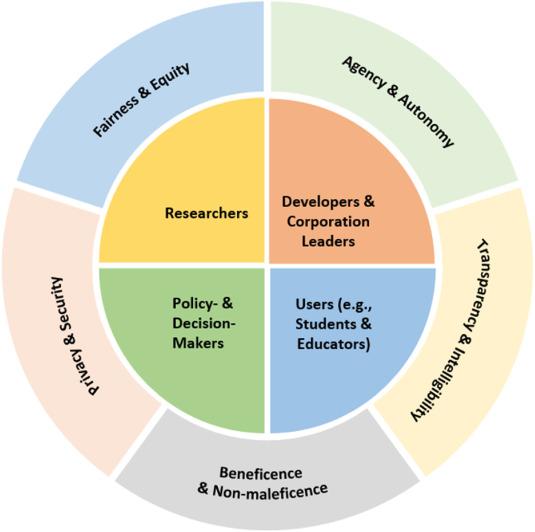Ethical Considerations in AI-Driven Learning: Navigating challenges and Safeguarding Student Rights
Artificial Intelligence (AI) has revolutionized the educational landscape, bringing powerful tools that can personalize learning, enhance student engagement, and optimize administrative processes. Though,as AI-driven learning becomes increasingly embedded in classrooms,ethical considerations in AI-driven learning come to the forefront. Educators, technology developers, policymakers, and parents must navigate complex challenges to safeguard student rights and maintain trust in education technology (EdTech). In this article, we will explore the primary ethical challenges, analyze case studies, offer practical solutions, and highlight the importance of responsible AI adoption in educational settings.
Understanding AI-Driven Learning in Education
AI-driven learning refers to the use of bright algorithms and data-driven tools to customize educational content, automate assessments, provide real-time feedback, and support both educators and learners. From adaptive learning platforms to AI-powered tutoring systems, these technologies promise to revolutionize education. yet, the rise of AI in schools brings with it notable questions regarding data privacy, bias, clarity, accountability, and student autonomy.
Key Ethical Considerations in AI-Driven Learning
Navigating the ethical landscape of AI in education means addressing the following core issues:
1. data Privacy and Security
- Data Protection: AI-powered platforms collect vast amounts of personal student data, including performance, behavior patterns, and even biometric facts.
- Risk of Breaches: Improper storage or use of student data can lead to privacy violations, unauthorized profiling, and cyberattacks.
- Compliance: Adhering to standards like GDPR, FERPA, and other regional regulations is crucial for legal and ethical operations.
2. Algorithmic Bias and Fairness
- Discrimination: biases in training data or algorithms may result in unfair treatment of students based on race,gender,socioeconomic background,or learning differences.
- Transparency: Many AI systems are “black boxes,” making it challenging to understand how decisions about students are reached,complicating efforts to detect and correct biases.
- Equity in Access: Ensuring all students, regardless of their background, benefit equally from AI-driven learning tools.
3. Student Autonomy and Consent
- Informed Consent: Students and their guardians must be aware of what data is being collected, how it’s used, and the potential ramifications.
- Loss of Agency: Over-reliance on AI recommendations can reduce students’ ability to make independent decisions about their education.
- Psychological Impact: The influence of AI on motivation and self-esteem must be considered,especially if technology provides constant feedback or tracking.
4. Accountability and Duty
- Who is Responsible?: Determining accountability when AI systems make mistakes or adverse decisions (developers, educators, institutions, or the AI itself).
- Recourse Mechanisms: Ensuring students have ways to appeal, challenge, or correct erroneous AI-driven outcomes.
The Benefits of Ethical AI in Education
When ethical considerations are thoroughly integrated, AI-driven learning can unlock tremendous educational advantages:
- Personalized Learning: Tailored lessons and pace according to the individual needs of each student.
- Data-Driven Insights: Help educators quickly identify areas where students excel or need extra support.
- Administrative Efficiency: Automated grading,attendance tracking,and resource allocation free up teacher time for human-centric activities.
- Enhanced Engagement: Interactive and adaptive content can make learning more appealing and accessible for all students.
Case Studies: The Real-World Impact of Ethics in AI-driven classrooms
A prominent AI-driven assessment platform implemented in schools across a major city was found to systematically underrate students from certain neighborhoods. Inquiry revealed the training data underrepresented these communities,resulting in biased predictions and impacting placement decisions. Swift actions to diversify training data and regular audits helped restore fairness and public trust.
In another instance, a popular education app suffered a data breach that exposed sensitive student information. This highlighted the urgent need for robust cybersecurity measures and transparent data management policies.The incident lead to the introduction of stricter privacy protocols and student consent forms.
A district working with an AI homework assistant focused on transparency by clearly explaining how recommendations were generated. Students and parents could access an understandable audit trail, improving acceptance and ensuring ethical compliance.
Practical Tips for Navigating Ethical Challenges in AI-Driven Learning
-
Prioritize Transparency:
Clearly communicate how AI tools function, what data is collected, and how it will be used to all stakeholders (students, parents, teachers).
-
Ensure Robust Data Privacy:
Adopt state-of-the-art encryption,restrict access,and regularly audit systems for vulnerabilities. Obtain explicit consent before gathering or processing student data.
-
Monitor and Mitigate Bias:
Regularly review algorithms and their outcomes for discriminatory patterns. Involve diverse groups in data collection and evaluation.
-
respect Student Autonomy:
Offer students and families meaningful choices about engaging with AI systems and allow them to opt out when feasible.
-
Establish Clear Accountability:
Define clear processes for reporting,investigating,and rectifying issues resulting from AI-driven decisions.
Best Practices for Safeguarding Student Rights in AI-Powered Learning Environments
- Involve Stakeholders Early: Include students, parents, teachers, and community members in discussions about adopting AI technology.
- Conduct Regular Ethical Audits: Independently review AI systems for privacy, bias, and fairness.
- Implement ongoing Training: Provide educators with up-to-date training in AI ethics and data protection protocols.
- Promote Digital Literacy: Equip students with the skills to understand, question, and challenge AI systems impacting their education.
- Champion Open source and Transparency: Whenever possible,use AI tools with transparent processes and accessible codebases.
Conclusion: Building Trust in AI-Driven Learning Through Ethical Action
The transformative potential of AI-driven learning is undeniable, yet it must be harnessed with a steadfast commitment to ethics and student rights. By prioritizing ethical considerations in AI-driven learning, schools and educational institutions can build trust, reduce risks, and create a fairer, safer, and more effective learning surroundings.
As AI continues to shape the future of education, ongoing dialog, transparency, and collaborative governance are essential. When educators, students, parents, and developers work together, we can ensure that technology empowers every learner—respecting privacy, promoting equity, and safeguarding the fundamental rights of all students.

